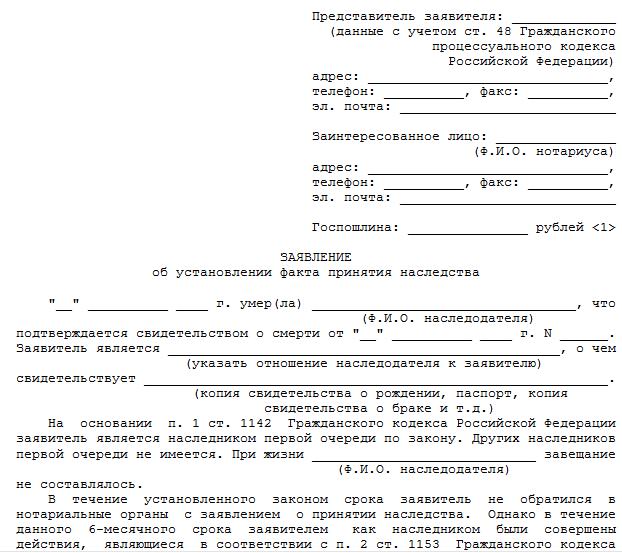An application to establish the fact of acceptance of the inheritance is submitted to the court. In what cases and for what purpose is this done? How is the document drawn up, what grounds are needed for its submission? What actions should be taken after?
General information
Inheritance is accepted in two ways:
- by writing a statement to a notary public within six months after the appearance of the inheritance;
- having actually accepted it without contacting a notary public in the 6-month period after the appearance of the inheritance.

In the second situation, the heir becomes the owner also from the moment of taking actions that are aimed at the seizure of property. However, all significant actions, for example, transactions with property (sale, gift) are allowed only after receiving documents for the property. Therefore, they turn to the notary. If he does not consider the confirmation of the acceptance of the inheritance sufficient, he sends the client to the court to file an application establishing the fact of acceptance of the inheritance.
Which court to apply to?
An application to establish the fact of acquiring the inheritance shall be submitted to the district court. All inheritance cases are excluded from the competence of justices of the peace. These requests are considered in a special order. If, in addition to revealing a fact, recognition of the right or the existence of a dispute is affected, then a statement of claim is filed.
How is paper written?
An application to establish the fact of acceptance of the inheritance is constructed according to a typical scheme, like all other appeals to the court:
- name of court;
- information about the applicant (F. I. O., place of residence);
- information on interested parties (other heirs);
- reasons for going to court;
- evidence justifying what is written in the statement;
- requests to the court to recover evidence to which the applicant does not have access, to call witnesses (their F.I.O., their place of residence, approximately what they will tell about);
- a request to establish the fact of acceptance of the inheritance (list objects);
- list of attached documents;
- receipt issued after payment of the state fee (its size is 300 rubles);
- signature and date of submission of papers to the court.

The number of sets is submitted according to the number of participants in the process and one for the judge.
Failure to comply with the requirements of the law gives reason to leave without motion a statement to the court establishing the fact of acceptance of the inheritance.
What circumstances are considered?
The heir began to manage and own property. This includes living in a house or apartment, using the land, caring for it, using the things of the deceased.
Takes measures to preserve property: installed locks on a door in a room belonging to a deceased person, transferred to his home something of value, for example, household appliances and other essential household items.

The applicant bears the costs of paying for utility bills, other obligatory payments, made repairs, leased the property, etc.
The acceptance of money that should have been paid to the testator (fees, debts, dividends, etc.) is also taken into account. Based on judicial practice, one of the listed actions is sufficient for the court to take into account the applicant’s words.
If part of the property is accepted, everything else is accepted.
What evidence is accepted?
Performing certain actions, the heir leaves documentary traces: receipts, payment orders, account statements, contracts, etc.
With their help, payment of taxes, utilities, repairs, etc. is confirmed.
Testimony is a separate source of information. They are added to documentary evidence.In this capacity are relatives, neighbors, close people.

Judges, wanting to make sure, interview witnesses about many aspects of family life that are known to really close people.
The sample application for establishing the fact of accepting the inheritance indicates the possibility of calling witnesses and how to formulate this request for the court.
One of them is in our article.
Filing a lawsuit
An application only to establish a fact is filed in the absence of a dispute about the right, in a case where there are no applicants for the property and all the rights of the deceased were drawn up as expected.
A lawsuit is filed when there is yet another applicant challenging the rights to the property, and possibly the one who has previously accepted the property and executed all the documents in the proper manner.
The second reason for filing a lawsuit is to challenge the law by the authorities. In fact, there is no dispute, but the plaintiff has no opportunity to draw up papers due to the fact that the testator did not draw up his rights in time.
How to write a statement?
The document looks as follows:
- name of court;
- F. I.O. of the plaintiff, his place of residence;
- F. I.O. of the defendant, his place of residence;
- notary public as a third party without independent requirements;
- management of Rosreestr, if one of the heirs has already registered ownership of disputed objects;
- The traffic police is involved if the deceased owned vehicles;
- statement of circumstances;
- request to court;
- list of attached documents;
- receipt issued after payment of state duty;
- Signature and date of transfer of documents to the court.
State duty
Unlike special production, the size of the state duty is determined by the price of the disputed property. An appraisal examination is appointed or it is enough to attach the appraiser’s report to the materials. Further, according to the norms of the Tax Code, the amount of the duty is calculated. If, in the court’s opinion, it has not been paid extra, the lawsuit remains motionless with the requirement to pay the required amount.
Grounds and claims
For example, the plaintiff asks to recognize the rights to 1/2 of the testator’s house in connection with the acceptance of the inheritance. He needs to provide the court with evidence that he has committed acts aimed at accepting property in the first half of the year after the appearance of the inheritance. And then there is a full dispute.

Proof of acceptance, as a rule, is not present as a claim.
The list of requirements is approximately the following:
- annul the record of the defendant's ownership of the property in the register of rights;
- recognize the rights to all property or to a share in it.
The issue of the fact of acceptance may not be raised as a separate requirement. Thus, the statement of claim on the fact of acceptance of the inheritance is not transferred to the court as such.
Filing an application on behalf of the deceased
Is a statement about the fact of acceptance of the inheritance of the deceased written? From the point of view of the law, dead people have neither rights nor duties. All of them either pass to the heirs, or cease to exist. And filing a court application for the recognition and protection of their rights is impossible.
Acceptance of inheritance by the deceased
As it was written above, the authorities do not formally recognize the rights of the heir due to the lack of a full package of documents. More often than not, ownership is not registered.

The testator could actually accept the inheritance after the previous owner died. This happens with older people who do not have time to complete the registration of property due to their health condition or lack of money.
What statement on establishing the fact of acceptance of the inheritance is filed in this situation?
If there is a dispute with someone else, then a lawsuit is filed, within the framework of which the fact of acceptance of the property by the deceased person is established, as a result of which the plaintiff and (or) the defendant acquired the rights after it.
If there is no dispute, then a statement is made to clarify the fact, and the applicant first proves the acceptance of the property by the testator, and then by himself.

If it is necessary to justify the fact that the inheritance was accepted as dead, a lawsuit is written on recognition of the right to property on behalf of the heir, in which these circumstances are proved, and the court leaves the ownership right for the applicant.
How does everything look in practice?
Consider a simple example of a statement establishing the fact of accepting an inheritance. After the death of a man, there remained an apartment in which he lived with his son. In a statement, the heir points to the fact of cohabitation, manifestations of concern for the father and the adoption of all his property.
Refers to the testimony of witnesses, on the receipt after payment of utility bills, an agreement on repair. It is indicated that all actions related to the acquisition of property were committed in the first half of the year after the father died.
As a reason for filing an application, it refers to the impossibility of filling out documents by a notary and the desire to formalize property rights.
Then a request for recognition of the fact of acceptance of the inheritance is stated, the attached documents are listed.
What to do with a court decision?
The court decision is transmitted to the notary. If a lawsuit was resolved, where, in addition to the fact, there was a request to recognize property rights, there is no need to contact a notary public. Documents are immediately transferred to the Federal Registration Service for registration.
